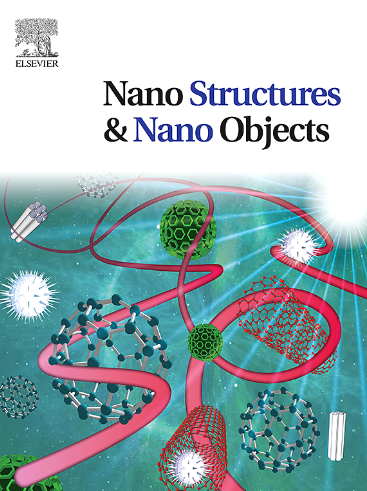Insights into the floral senescence effects of nanoparticles
IF 5.45
Q1 Physics and Astronomy
引用次数: 0
Abstract
Flowers could be valuable addenda to nanomedicine labs as in vivo models crossing the gap between the cell culture and small mammals. However, as it is shown here, floral models continue to be predominantly utilized within resource-limited research environments and remain largely underrepresented in mainstream biomedical investigations conducted by well-funded institutions in the developed world. The ability to delay the senescence of Orange Jubilee wildflowers was tested here on three types of nanoparticles: selenite-doped hydroxyapatite (HAp), citrate-stabilized HAp, and superparamagnetic iron oxide. Integration of selenite into the HAp crystal lattice produced a mild increase in the senescence rate relative to HAp. Iron oxide nanoparticles produced nil effects on senescence when added as powders and marginal effects when delivered as colloids. Colloidal stabilization of HAp nanoparticles with citrates significantly extended the flower viability, which was due to the ability of citrates to: (i) disperse the nanoparticles and thus facilitate their penetration into herbal tissues via their upward transfer along the xylem, and (ii) impart moderate acidity to the medium and thus intrinsically inhibit the growth of bacteria that block the flower stem and obstruct the water uptake. Orange Jubilee flowers prove as a solid, albeit pleiotropic model for assessing the biological barrier permeation and antibacterial activity of colloids and fine powders. Quests for similar in vivo models may result in less ambiguous and more effective models for the preclinical assessment of nanoparticles for uses in biomedicine.
纳米粒子对花卉衰老的影响
花可以作为纳米医学实验室有价值的补充,作为体内模型,跨越细胞培养和小型哺乳动物之间的差距。然而,正如这里所显示的,花卉模型仍然主要在资源有限的研究环境中使用,并且在发达国家资金充足的机构进行的主流生物医学研究中仍未得到充分代表。研究人员在三种类型的纳米颗粒上测试了延缓橙禧野花衰老的能力:亚硒酸盐掺杂羟基磷灰石(HAp)、柠檬酸盐稳定的HAp和超顺磁性氧化铁。亚硒酸盐与HAp晶格的结合使其衰老速率相对于HAp略有增加。氧化铁纳米颗粒作为粉末添加时对衰老没有影响,作为胶体递送时效果微乎其微。柠檬酸盐对HAp纳米颗粒的胶体稳定性显著延长了花的活力,这是由于柠檬酸盐的能力:(i)分散纳米颗粒,从而促进它们通过沿着木质部向上转移渗透到草药组织中;(ii)赋予介质适度的酸度,从而从本质上抑制阻碍花茎和阻碍水分吸收的细菌的生长。橙禧花被证明是一个固体的,尽管多效性模型,用于评估胶体和细粉末的生物屏障渗透和抗菌活性。寻求类似的体内模型可能会导致更少的模糊性和更有效的模型用于纳米颗粒在生物医学中的临床前评估。
本文章由计算机程序翻译,如有差异,请以英文原文为准。
求助全文
约1分钟内获得全文
求助全文
来源期刊

Nano-Structures & Nano-Objects
Physics and Astronomy-Condensed Matter Physics
CiteScore
9.20
自引率
0.00%
发文量
60
审稿时长
22 days
期刊介绍:
Nano-Structures & Nano-Objects is a new journal devoted to all aspects of the synthesis and the properties of this new flourishing domain. The journal is devoted to novel architectures at the nano-level with an emphasis on new synthesis and characterization methods. The journal is focused on the objects rather than on their applications. However, the research for new applications of original nano-structures & nano-objects in various fields such as nano-electronics, energy conversion, catalysis, drug delivery and nano-medicine is also welcome. The scope of Nano-Structures & Nano-Objects involves: -Metal and alloy nanoparticles with complex nanostructures such as shape control, core-shell and dumbells -Oxide nanoparticles and nanostructures, with complex oxide/metal, oxide/surface and oxide /organic interfaces -Inorganic semi-conducting nanoparticles (quantum dots) with an emphasis on new phases, structures, shapes and complexity -Nanostructures involving molecular inorganic species such as nanoparticles of coordination compounds, molecular magnets, spin transition nanoparticles etc. or organic nano-objects, in particular for molecular electronics -Nanostructured materials such as nano-MOFs and nano-zeolites -Hetero-junctions between molecules and nano-objects, between different nano-objects & nanostructures or between nano-objects & nanostructures and surfaces -Methods of characterization specific of the nano size or adapted for the nano size such as X-ray and neutron scattering, light scattering, NMR, Raman, Plasmonics, near field microscopies, various TEM and SEM techniques, magnetic studies, etc .
 求助内容:
求助内容: 应助结果提醒方式:
应助结果提醒方式:


